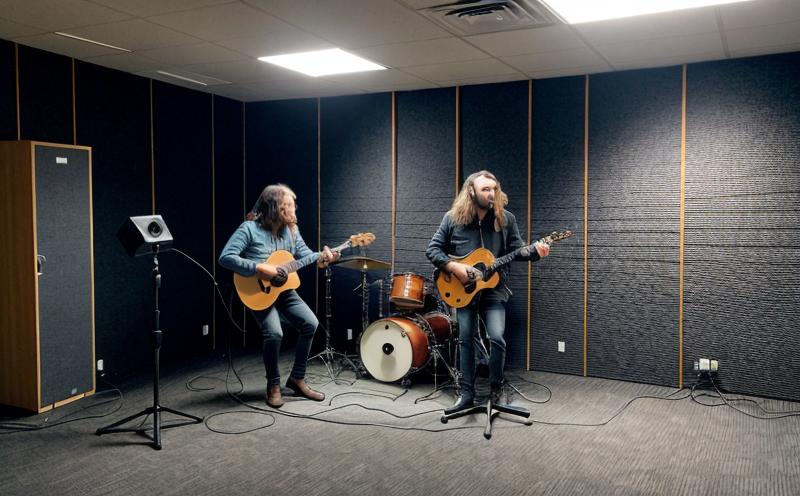EN ISO 11690-4 Guidelines for HVAC Noise Mitigation
The European Standard EN ISO 11690-4 specifies the requirements and procedures for determining the noise emission of HVAC (Heating, Ventilation, and Air Conditioning) equipment. This guideline is essential for ensuring that HVAC systems meet stringent acoustic performance criteria set by regulatory bodies across Europe.
Compliance with these guidelines ensures that HVAC units operate efficiently while minimizing their impact on the surrounding environment. The standard covers a wide range of equipment types including fans, compressors, and heat exchangers, each of which contributes to overall noise generation within an installation. By adhering to EN ISO 11690-4 standards during design, manufacturing, and operation phases, manufacturers can reduce potential complaints from residents or neighbors caused by excessive noise levels.
The testing process involves several key steps that ensure accurate measurement results. First, the equipment must be installed in a controlled environment where all variables such as temperature, humidity, and air flow rate are carefully regulated according to specified conditions outlined in the standard. Once properly set up, sound level meters are used to capture decibel readings at various angles around each piece of machinery being tested.
It's important to note that these measurements must be taken under specific operating conditions prescribed by EN ISO 11690-4. For example, certain fans may need to run continuously for a minimum amount of time before accurate data can be collected. Similarly, some compressors might require additional warm-up periods prior to testing.
After collecting initial data points from multiple positions around the equipment, engineers then analyze them using statistical methods provided in the standard. This helps identify any anomalies or outliers that could skew results and necessitate retesting under different settings if necessary.
The final step is generating a comprehensive report detailing all findings along with recommendations for improvement where applicable. Reports prepared according to EN ISO 11690-4 provide clear insights into areas where noise levels exceed acceptable limits, allowing manufacturers to take corrective actions promptly before products go into production.
Adhering to these guidelines not only helps maintain high standards of quality but also fosters innovation within the HVAC industry by encouraging continuous improvement in acoustic design practices. It ensures that new developments meet current regulatory requirements and contribute positively towards sustainability goals set forth by environmental organizations worldwide.
Benefits
Compliance with EN ISO 11690-4 offers numerous advantages for manufacturers, installers, and end-users alike. For companies involved in HVAC manufacturing, following this standard ensures that their products meet strict noise emission limits imposed by relevant authorities across Europe.
This can lead to improved market access as compliant equipment is more likely to pass inspections during installation processes or certification audits conducted by independent bodies. Additionally, meeting these standards enhances brand reputation and customer confidence since consumers expect reliable and environmentally friendly solutions from trusted brands.
For installers, working with equipment that has already undergone rigorous testing according to EN ISO 11690-4 reduces the risk of encountering compliance issues later down the line. This streamlines project timelines and minimizes disruptions caused by unforeseen challenges related to noise pollution.
From an end-user perspective, purchasing HVAC systems that comply with this standard translates into quieter living or working environments free from disruptive noises. Such installations contribute significantly towards creating healthier spaces where people can focus better on their tasks without being distracted by unwanted sounds.
Why Choose This Test
Selecting EN ISO 11690-4 for your HVAC noise mitigation testing is a strategic decision that offers several compelling reasons. One of the primary benefits lies in its comprehensive approach to addressing potential noise issues early on during product development stages.
The standard provides detailed instructions on how to conduct tests under realistic operating conditions, ensuring that any identified problems are accurately reflected before mass production begins. This proactive measure helps prevent costly rework efforts once products have entered the market, saving valuable resources and time.
Another advantage is its emphasis on continuous improvement through regular audits and updates based on evolving industry trends and customer feedback. By staying aligned with these standards, manufacturers can ensure they remain competitive in an ever-changing global marketplace where sustainability plays a crucial role.
Auditors familiar with EN ISO 11690-4 will find it easier to inspect facilities since the requirements are well-defined and documented clearly within this standard. This transparency fosters trust between stakeholders involved throughout the supply chain, promoting smoother collaboration efforts aimed at achieving common goals.
Quality and Reliability Assurance
The EN ISO 11690-4 guidelines play a pivotal role in maintaining consistent quality levels across various aspects of HVAC equipment manufacturing. One crucial aspect involves precise measurement techniques employed during testing procedures described within the standard.
To achieve accurate results, specialized sound level meters calibrated according to international standards like IEC 62278 are used. These instruments ensure that all measurements adhere strictly to prescribed tolerances, thus providing reliable data upon which decisions can be based confidently.
Another critical component is the selection of appropriate test environments that mimic real-world conditions experienced by HVAC units once installed in buildings. By replicating these settings accurately during testing, engineers gain valuable insights into how specific design elements affect noise performance under various scenarios.
The standard also places importance on documenting every stage of the testing process meticulously. This includes recording ambient conditions prevailing at the time of measurement as well as any adjustments made to ensure accurate readings. Such thorough documentation serves not only as proof of compliance but also aids in troubleshooting potential issues should they arise after deployment.
Furthermore, EN ISO 11690-4 promotes continuous quality assurance practices by encouraging periodic reviews and updates based on advancements in technology and best practices adopted globally within the HVAC industry. This ensures that even newly developed equipment continues to meet stringent noise emission limits set forth by this standard over extended periods.





